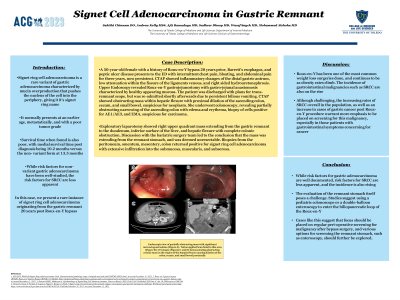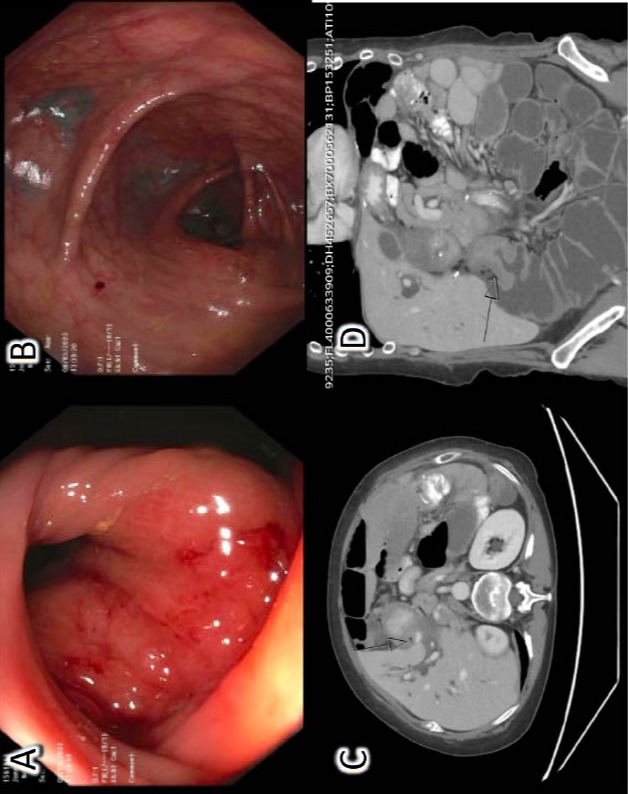Monday Poster Session
Category: Stomach
P2769 - Signet Ring Cell Adenocarcinoma in Gastric Remnant
Monday, October 23, 2023
10:30 AM - 4:15 PM PT
Location: Exhibit Hall

Has Audio
- SC
Sahithi Chinnam, DO
University of Toledo
Toledo, Ohio
Presenting Author(s)
Sahithi Chinnam, DO1, Andrew Kelley, 1, Ajit Ramadugu, MD2, Sudheer Dhoop, MD3, Wasef Sayeh, MD1, Mohammad Alshoha, MD4
1University of Toledo, Toledo, OH; 2University of Toledo College of Medicine, Toledo, OH; 3University of Toledo Medical Center, Toledo, OH; 4University of Toledo College of Medicine, Sylvania, OH
Introduction: Signet ring cell adenocarcinoma (SRCC) is a rare variant of gastric adenocarcinoma characterized by mucin overproduction. It normally presents at an earlier age, metastatically, and with a poor tumor grade. In this case, we present a rare instance of SRCC originating from the gastric remnant stomach 20 years post Roux-en-Y bypass.
Case Description/Methods: A 50-year-old female with a history of Roux-en-Y bypass 20 years prior, Barrett’s Esophagus, and peptic ulcer disease presents to the emergency department with chest pain, bloating, and abdominal pain for the past 3 years that have become lately more consistent. CT scan of the abdomen showed inflammatory changes of the distal gastric antrum, low attenuation within the fissure of the ligamentum venosum, and right sided hydroureteronephrosis. Upper Endoscopy revealed Roux-en-Y gastrojejunostomy with gastrojejunal anastomosis characterized by healthy appearing mucosa. The patient was discharged with plans for a trans-remnant scope. Due to bilious vomiting, she was re-admitted, and CT of the abdomen and pelvis showed an obstructing mass within the hepatic flexure with proximal dilation of the ascending colon, cecum, and small bowel, suspicious for neoplasm. She underwent colonoscopy, revealing partially obstructing narrowing in the ascending colon with edema and erythema, with biopsy of cells positive for AE1/AE3 and EMA, suspicious for carcinoma. Exploratory laparotomy showed right upper quadrant mass extending from the gastric remnant to the duodenum, inferior surface of the liver, and hepatic flexure with complete colonic obstruction. Biopsies were taken. Discussion with the bariatric surgery team led to the conclusion that the mass was extending from the remnant stomach, and it was it was deemed that the mass was unresectable. Biopsy results of the segmental colon resection showed signet ring cell adenocarcinoma with extensive infiltration.
Discussion: While risk factors for gastric adenocarcinoma have been well-studied, the risk factors for SRCC are less apparent, and the incidence is also rising. The evaluation of the remnant stomach itself poses a challenge, and studies suggest using a pediatric colonoscope or double-balloon enteroscopy to enter the bilio-pancreatic loop of the Roux-en-Y. Cases like this suggest that more focus should be placed on regular peri-operative screening for malignancy after bypass surgery, and various options for screening of the remnant stomach, such as enteroscopy, should further be explored.

Disclosures:
Sahithi Chinnam, DO1, Andrew Kelley, 1, Ajit Ramadugu, MD2, Sudheer Dhoop, MD3, Wasef Sayeh, MD1, Mohammad Alshoha, MD4. P2769 - Signet Ring Cell Adenocarcinoma in Gastric Remnant, ACG 2023 Annual Scientific Meeting Abstracts. Vancouver, BC, Canada: American College of Gastroenterology.
1University of Toledo, Toledo, OH; 2University of Toledo College of Medicine, Toledo, OH; 3University of Toledo Medical Center, Toledo, OH; 4University of Toledo College of Medicine, Sylvania, OH
Introduction: Signet ring cell adenocarcinoma (SRCC) is a rare variant of gastric adenocarcinoma characterized by mucin overproduction. It normally presents at an earlier age, metastatically, and with a poor tumor grade. In this case, we present a rare instance of SRCC originating from the gastric remnant stomach 20 years post Roux-en-Y bypass.
Case Description/Methods: A 50-year-old female with a history of Roux-en-Y bypass 20 years prior, Barrett’s Esophagus, and peptic ulcer disease presents to the emergency department with chest pain, bloating, and abdominal pain for the past 3 years that have become lately more consistent. CT scan of the abdomen showed inflammatory changes of the distal gastric antrum, low attenuation within the fissure of the ligamentum venosum, and right sided hydroureteronephrosis. Upper Endoscopy revealed Roux-en-Y gastrojejunostomy with gastrojejunal anastomosis characterized by healthy appearing mucosa. The patient was discharged with plans for a trans-remnant scope. Due to bilious vomiting, she was re-admitted, and CT of the abdomen and pelvis showed an obstructing mass within the hepatic flexure with proximal dilation of the ascending colon, cecum, and small bowel, suspicious for neoplasm. She underwent colonoscopy, revealing partially obstructing narrowing in the ascending colon with edema and erythema, with biopsy of cells positive for AE1/AE3 and EMA, suspicious for carcinoma. Exploratory laparotomy showed right upper quadrant mass extending from the gastric remnant to the duodenum, inferior surface of the liver, and hepatic flexure with complete colonic obstruction. Biopsies were taken. Discussion with the bariatric surgery team led to the conclusion that the mass was extending from the remnant stomach, and it was it was deemed that the mass was unresectable. Biopsy results of the segmental colon resection showed signet ring cell adenocarcinoma with extensive infiltration.
Discussion: While risk factors for gastric adenocarcinoma have been well-studied, the risk factors for SRCC are less apparent, and the incidence is also rising. The evaluation of the remnant stomach itself poses a challenge, and studies suggest using a pediatric colonoscope or double-balloon enteroscopy to enter the bilio-pancreatic loop of the Roux-en-Y. Cases like this suggest that more focus should be placed on regular peri-operative screening for malignancy after bypass surgery, and various options for screening of the remnant stomach, such as enteroscopy, should further be explored.

Figure: Endoscopic view of partially obstructing mass with significant narrowing and edema (Figure A). Tattoo applied 5cm distal to this area (Figure B). CT images (Figures C and D) demonstrating obstructing colonic mass in the region of the hepatic flexure causing dilation of the colon, cecum, and small bowel proximally
Disclosures:
Sahithi Chinnam indicated no relevant financial relationships.
Andrew Kelley indicated no relevant financial relationships.
Ajit Ramadugu indicated no relevant financial relationships.
Sudheer Dhoop indicated no relevant financial relationships.
Wasef Sayeh indicated no relevant financial relationships.
Mohammad Alshoha indicated no relevant financial relationships.
Sahithi Chinnam, DO1, Andrew Kelley, 1, Ajit Ramadugu, MD2, Sudheer Dhoop, MD3, Wasef Sayeh, MD1, Mohammad Alshoha, MD4. P2769 - Signet Ring Cell Adenocarcinoma in Gastric Remnant, ACG 2023 Annual Scientific Meeting Abstracts. Vancouver, BC, Canada: American College of Gastroenterology.
